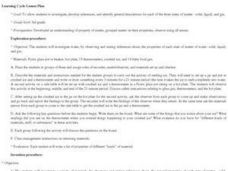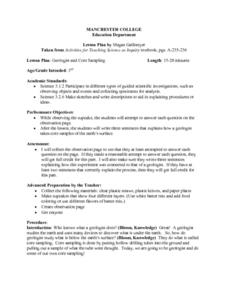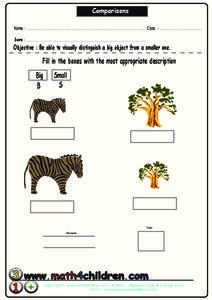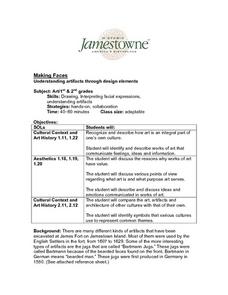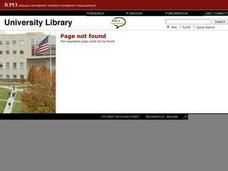Curated OER
Curious Curators
Students write a theme statement for a collection of diverse objects. Using the internet, they research and write descriptions of various artifact. They role play the role of a museum curator and produce a museum style exhibition. ...
Curated OER
Learning Cycle Lesson Plan
students investigate, develop inferences, and identify general descriptions for each of the three states of matter - solid, liquid, and gas. students investigate water, by observing and stating inferences about, the properties of each...
Curated OER
World Geography: Who am I?
Students are able to provide a basic description of one country that has arsenic in its water supply. They are able to locate these countries on a map. Students explore the majors countries that have been affected by arsenic...
Curated OER
HIT THE TRAIL
Students draw three cattle trails that passed through Indian Territory, using a written description of the trails and will create a diary of trail life. Students research a historical trail as assigned. Students share their information...
Curated OER
Science: Bugs and Body Parts
Students determine the function of various insect parts they have observed. Using descriptive words, they explain the insects' characteristics and draw pictures of them. The lesson concludes with students writing short sentences...
Curated OER
Love Them or Leave Them?
Students describe their pet and their feelings towards it and record their descriptive phrases on the board. They arrange comments on a spectrum from negative to positive. They read the article The Ambivalent Bond With a Ball of Fur and...
Curated OER
Probability
In this probability instructional activity, 6th graders solve and complete 3 different problems. First, they place the events on the probability scale shown. Then, students match the phrase to the best description of its chance of...
Curated OER
Exploring Photographs - Writing the Artist's Statement
Students read an artist's statement by Dorothea Lange and write a statement based on their own photographs. In this photograph and writing lesson, students examine the relationship between photography and the artist's statement. Students...
Curated OER
Archaeology 2500: Texano Weapons
Students listen to oral story describing mystery artifact, work in groups to write descriptive report of artifact, and creatively form hypothesis based purely on misinterpretation. Students then explore and discuss difficulty of...
Curated OER
Geometric Figures
Students identify two and three dimensional shapes and use appropriate geometric vocabulary to write a description of the figure by taking pictures of geometric figures in their own environment.
Curated OER
Geologist and Core Sampling
Third graders observe a cupcake and attempt to answer each question on the observation page. They write three sentences that explains how a geologist takes core samples of the earth's surface. Students make sketches and write...
Curated OER
Comparisons
In this size comparisons worksheet, students study the image and fill in the box with the most appropriate description. Students write either big or small for the image.
Curated OER
Japanese Objects as Cultural Artifacts: A Model Lesson Using Textiles
Pupils complete a unit on the cultural significance of textiles in the Japanese culturre. They analyze cotton, line, silk, and wool fabrics, examine various fabric creation and decoration techniques, select an object and write a detailed...
Curated OER
From Lake to Lake
Fourth graders investigate the formation of the Great Salt Lake. They conduct research using a variety of resources. The information is used to construct a timeline of the history. Each phase of history should include facts and...
Curated OER
Adaptations To the Environment
Students design and construct an imaginary animal that is perfectly adapted to a particular type of biome. They give the animal a scientific name, place it in a phylum and write descriptions about its behavior, reproduction, foraging,...
Curated OER
Antonym Comparison of Animals and Me
Students explore the purpose of antonyms. In this language arts lesson, students create a list of words to describe animals. Students use the list to generate antonyms for each descriptive word.
Curated OER
Any Town, USA
Students launch an investigation of their home town by creating a mental map and examining the livability factors from their perspective. After completing their map, students write a brief description of their town
Curated OER
Geology
Fourth graders devise a workable inch-to-inch scale for a geologic timeline sequencing the eras covered in the unit. They hypothesize from descriptions of dinosaur fossil evidence.
Curated OER
Joseph Raffael
Students examine and discuss a painting of a lizard by the artist Joseph Raffael. They list descriptive words about the lizard, and write a Cinquain and create a painting about a lizard.
Curated OER
Tunnel Traps
Students identify shapes that match specific shape descriptions involving a range of geometric terms and correct polygon names. They utilize a mathematics educational software program to gain practice.
Curated OER
Making Faces: Understanding Artifacts Through Design Elements
Learners examine and discuss drinking container artifacts from Jamestown. They view images of the artifacts, discuss their purposes, draw an original facial expression for a brown paper jug, and write a description of the facial expression.
Curated OER
Cartographer and Journalish as Storytellers
Students collaborate in groups of four students to create a written description of their community during a specific year. They analyze data provided by maps and newspaper articles. They meet as a whole class to discuss their conclusions.
Curated OER
Salmon and Steelhead Life Stories Web Search
Students conduct an Internet investigation to discover the natural history of local salmon and/or steelhead. They then write a story that describes the life of a salmon or steelhead from the local creek, including a description of each...
Curated OER
Romare Bearden and the Face Collage
Fourth graders create a collage from magazines and newspapers to create a face. After finishing the face, they use mixed media to complete the background. They write their own description and examine the life and works of Romare Beardon.

